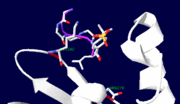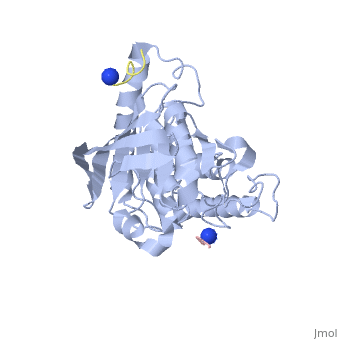Yersinia YopH (Yop51) is a virulence factor of bacteria of the genus Yersinia, which includes Y. pestis (which can manifest in one form as bubonic plague), Y. pseudotuberculosis, and Y. enterocolitica. YopH is a protein tyrosine phosphatase (PTPase) which is injected into infected cells by a type III secretion mechanism[1][3] (1xxv).
Yersina Outer Proteins
Yersinia is a genus of Gram-negative bacteria which are pathogenic to various animal species including humans[1]. It includes the species Y. pestis the agent of plague (bubonic plague, pneumonic plague, septicemic plague), Y. pseudotuberculosis (which causes mesenteric lymphadenitis), and Y. enterocolitica (mild gastroenteritis)[1][4]
Various Yersinia outer proteins, or Yops, play a role in pathogenesis. These genes are encoded on a virulence plasmid. Of these, seven are key for virulence. These bacteria replicate in lymphatic tissue and need to evade host defenses[5]. Some of the mechanisms by which it does this include anti-phagocytosis, cytokine inhibition, and the promotion of macrophage apoptosis[5][6]. Yops may perform many functions, including forming an apparatus to secrete effectors into the host cell, regulating this secretion, and acting as effectors in the host cell.
In Yersinia, a type III secretion system allows for various proteins to be transferred directly from the cytoplasm of the bacterium to the cytoplasm of the host cell directly, enabling the mechanisms that allow the bacteria to evade host defenses and thus allowing them to replicate in lymphatic tissue[5]. In type III secretion systems, secreted proteins lack a cleavable signal peptide (seen in the sec-mediated pathway), and they often have very specific chaperone proteins[5]. The type III secretion system is made with YopB, YopD, and it is believed that other Yops are also involved such as LcrV. It is regulated by Yops such as YopN and the hierarchical order of secretion. The effector Yops include YopE (inhibits phagocytosis by disrupting actin skeleton), YpkA/YopO, YopM, YopP (YopP/YopJ induces apoptosis by an unknown mechanism) and YopH [5][7].
YopH is carried by the chaperone SycH to the secretion system, and is regulated by the protein LcrQ, which is a competitive inhibitor for YopH binding of LcrQ. There is a specific order, or "hierarchy", of transport into host cells since this regulatory protein preferentially binds the chaperone[6]. Once in the host cell, YopH is responsible for disrupting focal adhesion and inhibiting phagocytosis by macrophages[5]. It appears to be specifically targeted to the focal adhesion complexes (in HeLa cells)[4].
YopH Structure
YopH is a 51kDa, 468 amino acid protein with two domains linked by a proline rich sequence[1][7]. Residues 1-129 form the N-terminal domain which contains a binding site ("site 1") for substrate targeting[1]. This site is not catalytic, and the binding domain appears to be unique among phosphotyrosine binding domains as it does not resemble SH2 (Src homology 2) or PTB (phospotyrosine-binding) domains[1]. The second domain is the catalytically active domain with a mixed β-sheet in the center of the protein, surrounded by α-helices[8]. This domain encompasses the residues from approximately 163-468, and has two binding sites[1]. One appears to be involved in substrate specificity ("site 2"), while the other is the catalytic site[1].

The catalytic domain of YopH. The C-terminal residue is coloured in red, the residue closest to the N-terminal of the protein is coloured in blue, the phosphate binding loop is coloured green, and the phosphopeptide ligands are purple.
(1k46) is important for secretion, binding of SycH, and binding of the substrates to the catalytic domain. This domain contains four α-helices and four β-sheets in an α+β arrangement[9]. The amino-terminal α-helix (residues 2-17) makes up the secretion signal[9]. Since there does not appear to be a conserved signal sequence between secreted proteins in type III secretion systems, nor a signal peptide cleaved, it has been suggested that recognition of secreted proteins may be by a structural motif, such as an amphipathic helix[9]. The chaperone SycH binds to residues 20-70 in a hydrophobic patch from a nascent or partially unfolded N-terminal domain[9].
The (1xxv), contains seven α-helices and a mixed β-sheet with eight strands, with two βαβ motifs in the center[8]. X-ray crystallography (using a phosphopeptide substrate which resembles the autophosphorylation site on EGFR) suggests that there are two substrate binding sites on this domain. Site 2 appears be more specific than the active site as it binds 5-6 residues, while the active site only binds 3-4 of these substrate residues [1]. In site 2, the phosphotyrosine binds with its ring parallel to the protein surface, and it forms salt bridges with two residues, Arg 278 (salt bridge to the phosphate) and Lys 342 (salt bridge to: phosphonate oxygens, fluorine atom, and Glu4 of substrate)[1].
In the active site, residues 403-410 form a phosphate binding loop (P-loop)[1]. The first residue in this loop is crucial for enzyme activity. If the cysteine at position 403 () is substituted with serine,the enzyme will be catalytically inactive and will trap the substrate[1]. Another crucial residue also lies within this P-loop. If arginine 409 is substituted to serine, substrate binding and catalysis is inhibited (it does not trap the substrate like the Cys 403 mutation to Serine)[1].
Given that the catalytic site and site 2 are on 'opposite sides' of the protein, Ivanov et al. [1] suggest that the protein may function with site 1 (on the N-terminal domain) and site 2 bound to one Cas molecule. This leaves the active site on the opposide side of the protein free to bind and dephosphorylate an adjacent Cas. In addition, binding of Cas may be aided by interactions from residues 223-226; however, these were not essential for this interaction[1].
Function

Key residues involved in forming salt-bridges with the substrate in site 2 on the catalytic subunit
During infection, the Yersinia bacteria are attached to the host cells, but cannot be ingested. In order to prevent this, protein tyrosine kinase activity in the host cell must be inhibited. Since focal adhesion (locations where the actin cytoskeleton is linked to the extracellular matrix) assembly is part of the signal cascade involved in the process of clustering of β-1 integrins and tyrosine kinase activity in response to pathogens, the protein tyrosine phosphatase (PTPase) activity of YopH could disrupt this interaction and thus prevent uptake of the bacteria. Focal adhesion kinase (FAK) and p130 Cas are both phosphorylated in response to the integrin-mediated focal adhesion assembly. YopH has been shown to dephosphorylate both FAK and p130 Cas with a high specificity, thereby blocking the uptake of the bacteria by the host cell ("anti-phagocytosis")
[3]. YopH has also been shown to interact with and dephosphorylate Fyn-binding protein
[4].
Mechanism
A suggested mechanism for YopH dephosporylating action is that the Cys 403 residue forms a phosphocysteine intermediate[7]. A unique feature of this protein is the Cys 403 residue, which is a key component in catalysis of dephosphorylation[8]. The pKa on the sulfhydryl group appears to be around 4.7, instead of the typical dissociation constant in most proteins for this residue, and thus it is likely stabilized by several H-bonds in the negative thiolate form (~pKa 8.5)[8].
Other PTPases, such as PTP1B, use highly coordinated H-bonds from the P-loop to the substrate and intermediates, enabling them to form a phosphocysteine intermediate[10]. In PTP1B, the electron donor is a water molecule that forms a hydrogen bond with a catalytic Asp residue and is coordinated by a Gly residue, which may be similar to the action of YopH[10].

The mechanism proposed here is only the most commonly suggested mechanism. Several studies were unable to prove a direct interaction between YopH and Cas or Fyn-binding protein, nor were they able to confirm the general mechanism by which YopH inhibits phagocytosis of the bacterium[4][11]. For instance, it has not been confirmed that several of YopH's substrates are tyrosine-phosphorylated as part of the integrin-mediated response to binding of the bacterium, and thus it may have a different mechanism of action[4][11].




